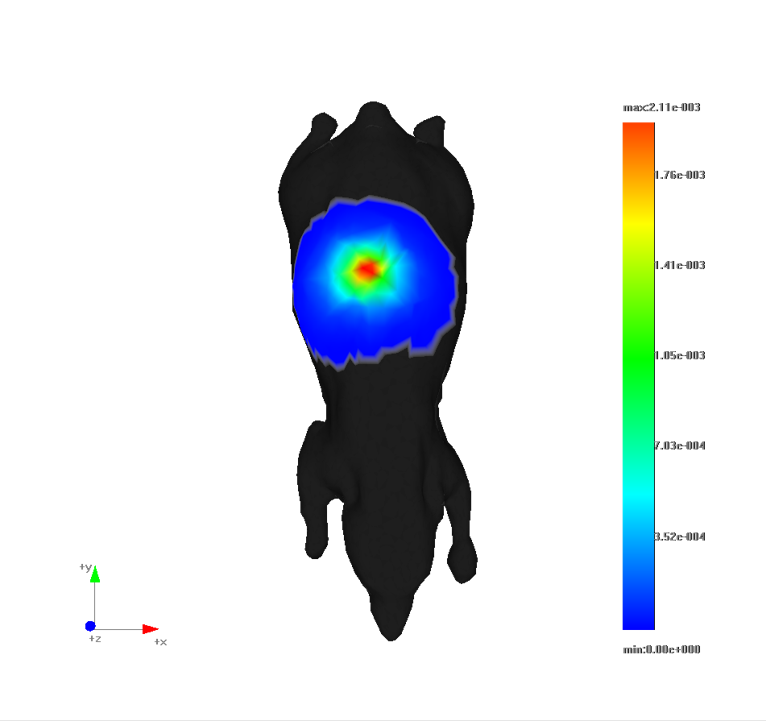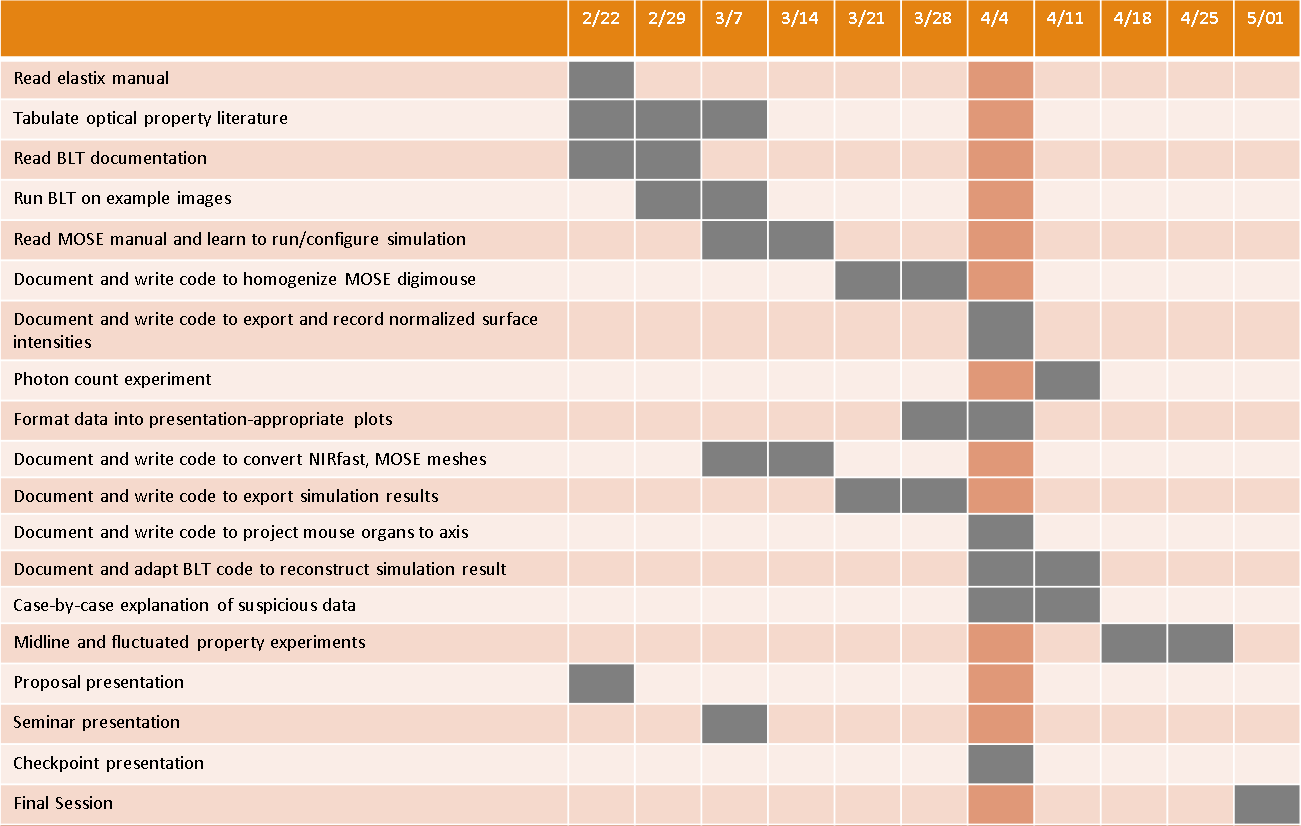Table of Contents
Project 15: Mouse Segmentation and Optical Properties for Bioluminescence Tomography (BLT)
Last updated: May 5, 2016
Summary
Project 15 is to gather literature values for the optical properties of mouse organs for incorporation into bioluminescence tomography (BLT) reconstruction. Furthermore, this project aims to investigate the effects of mouse heterogeneity on the accuracy of center-of-mass (COM) reconstruction by using the Molecular Optical Simulation Environment (MOSE) to solve the forward light transport problem for a heterogeneous mouse. Project 15 also aims to produce an automatic mouse segmentation process and to perform experiments with physical light source implants in mice. Update: the automated mouse segmentation and physical implant experiments are no longer planned.
- Students: Alan Cham
- Mentor(s): Ken Wang, Bin Zhang, Junghoon Lee

Background, Specific Aims, and Significance
The Small Animal Radiation Research Platform (SARRP) is a preclinical research tool for mouse CBCT imaging and radiation delivery. In order to improve radiation targeting of low-contrast tissues, BLT functionality has been implemented for the SARRP. Previous experiments involved physical light source implants in relatively homogenous region of the mouse (abdomen), and the reconstruction was performed under assumption that the body homogeneously bears the properties of adipose tissue. Nonetheless, center of mass (COM) targeting accuracy of 1 mm has been achieved using the homogeneity assumption. Information about the optical properties of mouse organs and their spatial distribution of those organs may help improve BLT reconstruction results. Project 15 aims to augment the existing BLT workflow through the following aims:
- Gather literature values of mouse organ optical properties and evaluate their distribution.
- Automate the segmentation of cone beam computed tomography (CBCT) images of mice.
- Modify the BLT workflow to intake simulated and physical implant results in heterogeneous models, and investigate the effects of heterogeneity on reconstruction accuracy in different areas of the mouse.
Update: the automated segmentation and physical implant experiments are no longer planned.
Deliverables
- Minimum: April 29, 2016 or before
- Tabulated literature values for optical properties
- Presentation of formatted/plotted properties
- Documentation of point-by-point justification for suspect data points
- Manually segmented mouse images for atlas and simulated source experiments
- Update: this deliverable is cancelled.
- Documented modifications to Matlab code to incorporate organ specific optical properties
- Clarification: Documented modifications to Matlab code to reconstruct heterogeneous simulation results.
- Code, workflow, and documentation for simulation experiments using MOSE
- Documented results for determining optimal photon count for Monte Carlo simulation.
- Documentation of simulation experiment results.
- Expected: April 29, 2016 or before
- Code, workflow, and documentation for registering new images to atlas set using elastix
- Update: this deliverable is cancelled.
- Matlab code for multi-classifier decision fusion strategy
- Update: this deliverable is cancelled.
- Maximum: April 15, 2016 or before
- Perform BLT experiment on implanted light source in specific organ
- Update: this deliverable is cancelled.
- Determine optimal optical property value sets for reconstruction
Technical Approach
- Optical Properties: In this segment of the project, I aim to cull literature values for optical properties (reduced scattering and absorbance) that were obtained in experiments or used in previous optical projects, or calculate from given parameter values as in the case of Alexandrakis, in a given body of articles. Values are collected regardless of species or experimental method. Due to extensive discrepancies in the collected data, a case-by-case explanation will be provided for each suspect point to suggest inclusion or exclusion of the point. Also, the data will be formatted into presentation-appropriate plots and used to produce suggestions of optical property values to be used in simulation and reconstruction.

- Optical Simulations: In this segment of the project, I aim to produce a workflow for running optical simulations on the Molecular Optical Simulation Environment (MOSE). This requires documentation of the MOSE simulation environment setup to match the SARRP configuration. MOSE is used to solve the BLT forward problem via Monte Carlo methods. The output of the the simulation is a table of the transmittance at each tetrahedral mesh vertex. The BLT reconstruction code will be slightly modified to take input from the simulation results, after the digimouse mesh and transmittance measurements have been converted to the NIRfast formats used by the BLT implementation. In order to determine the optimal photon count for the Monte Carlo simulation, a homogeneous mouse mesh will be used to produce multiple surface transmittance mappings and the number of photons will increase until normalized transmittance values converge. Afterward, a simulated 3 mm spherical light source will be translated along a heterogeneous mouse model's mid-line, spanning from relatively homogeneous areas, such as the abdomen, to relatively heterogeneous areas, such as the chest. BLT reconstruction results will be compared with ground truth source position and the error will be plotted against position along the axis, overlaid with each tissue's projection onto the axis.

- Atlas-Based Segmentation: In this segment of the project, I aim to produce a workflow/tool to expedite an approximate segmentation of the mouse body to be used in BLT reconstruction. The tool will be a matlab function calls features from the elastix software package to register several atlas images to the same space as an input image. Then multi-classifier decision fusion strategy is used to produce a segmented image. Update: this portion of Project 15 is cancelled.
Dependencies
Status: all dependencies have been met.
- Implant Experiment Results BLI and CBCT Images: to be sought from mentors.
- Update: No longer needed since implant experiments are no longer planned.
- Mouse CBCT Images for Atlas-Based Segmentation Tool: to be sought from mentors.
- Update: No longer needed since auto-segmentation aim is no longer planned.
- Mouse CBCT Images and Code for Virtual Experiment: images to be sought from mentors, and code to be written
- Update: Molecular Optical Simulation Environment (MOSE), free software to run Monte Carlo simulations for virtual light sources will be used. MOSE also includes tools for mesh simplification and boundary extraction, as well as a digimouse mesh.
- BLT Reconstruction Matlab Code: obtained.
- SARRP/BLT Workflow Documentation: obtained.
- NIRfast Light Transport Modeling Software: obtained.
- Deformable registration software: free software package Elastix will be used.
- Update: No longer needed since auto-segmentation aim is no longer planned.
- Code and Documentation Storage: project wiki page will be used.
Milestones and Status

- Read elastix manual
- Planned Date: 2.27
- Expected Date: 2.27
- Status: OK
- Read BLT documentation
- Planned Date: 3.5
- Expected Date: 3.5
- Status: OK
- Run BLT on example images
- Planned Date: 3.10
- Expected Date: 3.10
- Status: OK
- Manually segment mouse atlases
- Planned Date: 3.26
- Expected Date: N/A
- Status: Cancelled
- Determine elastix registration parameters to use.
- Planned Date: 4.2
- Expected Date: N/A
- Status: Cancelled
- Automatic segmentation workflow.
- Planned Date: 4.30
- Expected Date: N/A
- Status: Cancelled
- Tests with implanted light source.
- Planned Date: 4.16
- Expected Date: N/A
- Status: Cancelled
- Tabulate optical property LUT.
- Planned Date: 3.5
- Expected Date: 3.10
- Status: OK
- Format data into presentation-appropriate plots
- Planned Date: 4.11
- Expected Date: 4.11
- Status: OK
- Case-by-case explanation of data discrepancy and suggestions for inclusion/exclusion
- Planned Date: 4.15
- Expected Date: 4.15
- Status: OK
- Read MOSE manual and learn to configure/run simulation.
- Planned Date: 3.15
- Expected Date: 3.15
- Status: OK
- Document and write code to homogenize regions of MOSE digimouse
- Planned Date: 3.30
- Expected Date: 3.30
- Status: OK
- Document and write code to record normalized surface intensity.
- Planned Date: 4.11
- Expected Date: 4.11
- Status: OK
- Experiments to determine optimal photon count for simulation
- Planned: 4.15
- Expected Date: 4.15
- Status: OK
- Document and write code to inter-convert NIRfast and MOSE mesh formats.
- Planned Date: 3.15
- Expected Date: 3.15
- Status: OK
- Document and write code to map MOSE simulation output .t.cw to NIRfast .paa and .meas files.
- Planned Date: 3.28
- Expected Date: 3.28
- Status: OK
- Document and write code to project mouse organs to axis.
- Planned Date: 4.11
- Expected Date: 4.11
- Status: OK
- Document and adapt BLT code to reconstruct from MOSE simulation results.
- Planned Date: 4.15
- Expected Date: 4.15
- Status: OK
- Run experiments along heterogeneous mouse midline.
- Planned Date: 4.29
- Expected Date: 4.29
- Status: OK
- Implant experiments.
- Planned Date: 4.29
- Expected Date: N/A
- Status: Cancelled
Reports and Presentations
- Project Plan
- Project Background Reading
- See 'Project Bibliography' below for references.
- Project Checkpoint
- Paper Seminar Presentations
- Project Final Presentation
- Project Final Report
- Appendices or other material: see 'Other Resources and Project Files' below
Project Bibliography
Project Background
- Bin Zhang, Ken Kang-Hsin Wang, Jingjing Yu, Sohrab Eslami, Iulian Iordachita, Juvenal Reyes, Reem Malek, Phuoc T. Tran, Michael S. Patterson, and John W. Wong. “Bioluminescence Tomography-Guided Radiation Therapy for Preclinical Research”. International Journal of Radiation Oncology*Biology*Physics.
Elastix
- S. Klein, M. Staring, K. Murphy, M.A. Viergever, J.P.W. Pluim, “elastix: a toolbox for intensity based medical image registration,” IEEE Transactions on Medical Imaging, vol. 29, no. 1, pp. 196 - 205, January 2010.
- D.P. Shamonin, E.E. Bron, B.P.F. Lelieveldt, M. Smits, S. Klein and M. Staring, “Fast Parallel Image Registration on CPU and GPU for Diagnostic Classification of Alzheimer’s Disease”, Frontiers in Neuroinformatics, vol. 7, no. 50, pp. 1-15, January 2014.
Molecular Optical Simulation Environment (MOSE)
- User's Manual for Molecular Optical Simulation Environment, version 2.3. Blacksburg, VA. Virginia Polytechnic Institute and State University (2012).
Image Segmentation
- Rohlfing, T., Brandt, R., Menzel, R., & Maurer Jr., C. R. (2004). Evaluation of atlas selection strategies for atlas-based image segmentation with application to confocal microscopy images of bee brains. Neuroimage, 21(4), 1428-1442. doi:http://dx.doi.org/10.1016/j.neuroimage.2003.11.010
Optical Properties
- Alexandrakis G, and Rannou FR, and Chatziioannou AF. - Tomographic bioluminescence imaging by use of a combined optical-PET (OPET) system: A computer simulation feasibility study. - Physics in Medicine and Biology(- 17):- 4225.
- Honda N, Ishii K, Terada T, Nanjo T, Awazu K; Determination of the tumor tissue optical properties during and after photodynamic therapy using inverse monte carlo method and double integrating sphere between 350 and 1000 nm. J. Biomed. Opt. 0001;16(5):058003-058003-7. doi:10.1117/1.3581111.
- Kienle, A., Lilge, L., Patterson, M.S., Hibst, R., Steiner, R., and Wilson, B.C. “Spatially resolved absolute diffuse reflectance measurements for noninvasive determination of the optical scattering and absorption coefficients of biological tissue,” Appl. Opt. 35, 2304-2314 (1996)
- Torricelli, A., Pifferi, A., Taroni, P., Giambattistelli, E., Cubeddu, R. (2001). In vivo optical characterization of human tissues from 610 to 1010 nm by time-resolved reflectance spectroscopy. Physics in Medicine and Biology, 46(8), 2227.
- Bashkatov, A.N., Genina, E.A., Tuchin, V.V. (2011). Optical properties of skin, subcutaneous, and muscle tissues: A review. Journal of Innovative Optical Health Sciences, 04(01), 9-38.
- Cheong, W., Prahl, S.A., & Welch, A. J. (1990). A review of the optical properties of biological tissues. Quantum Electronics, IEEE Journal of, 26(12), 2166-2185.
- Firbank, M., Hiraoka, M., Essenpreis, M., and Delpy, D.T. (1993). Measurement of the optical properties of the skull in the wavelength range 650-950 nm. Physics in Medicine and Biology, 38(4), 503.
- Sandell, J.L., & Zhu, T.C. (2011). A review of in-vivo optical properties of human tissues and its impact on PDT. Journal of Biophotonics, 4(11-12), 773-787.
- Jacques SL, Prahl SA. Modeling optical and thermal distributions in tissue during laser irradiation. Lasers Surg Med. 1987;6:494–503.
- Jacques, S.L. (2013). Optical properties of biological tissues: A review. Physics in Medicine and Biology, 58(11), R37
- Welch, A.J, Gemert, M.J.C. Optical-thermal response of laser-irradiated tissue. Dordrecht: Springer; 2011
Other Resources and Project Files
Here give list of other project files (e.g., source code) associated with the project.
- !!Note: Documentation.README.docx in Technical Appendices VI is still needing some finishing touches!!